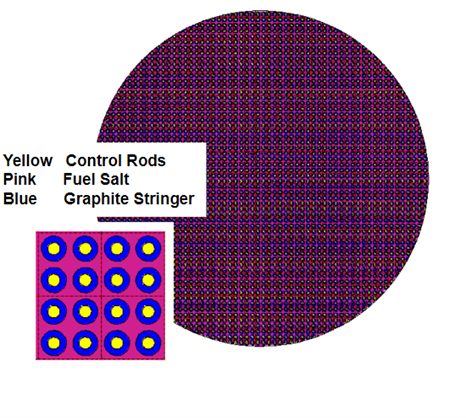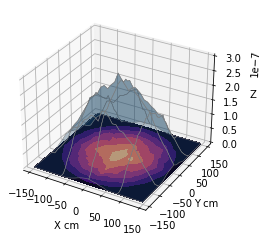The purpose of this project is to create a design of a molten salt reactor that breeds uranium fuel from thorium throughout its life cycle. The power output of this reactor is 300 MW thermal and 100 MW electric. Two methods of reactivity control have been incorporated in this design, namely control rods and dissolved boron. The molten salt fuel circulates through the primary loop of the reactor, passing through a graphite moderator stringer in the core. Unlike a traditional light water reactor, the moderator is stationary, and the fuel is dissolved in the coolant. Fission is confined to the core, which is the only region with enough moderator to sustain the chain reaction. The neutron flux in the core not only induces fission, but also transforms thorium-232 into the fissile isotope uranium-233 via neutron capture. As a result, there is no requirement for enriched uranium in the fuel. By determining a reactor geometry that results in a critical k-value, it was possible to conduct thermal hydraulic analysis to ascertain the power output of the core configuration. The core geometry was refined by making adjustments to core parameters until both a critical k-value was achieved, and the target power output was attained. Figure [1] shows the core model in MCNP, including the molten salt fuel and the graphite stringer. The control rod shafts are yellow, the fuel salt is pink, and the graphite moderator is blue.
Team: Tierney Dugan, Ashley Harris, Nicholas Nilsen, Hadrian Vaupel
Project Advisors: Prof. Yaron Danon

Members of the design group
Project Motivation
The future of nuclear reactors is in small modular reactors (SMRs) as they require significantly less upfront cost and time to construct than a full sized power plant. They will play a vital role in decreasing our reliance on fossil fuels. Our project focuses on designing the core of a thorium molten salt breeder reactor (MSBR). In the 1960s, Oak Ridge National Laboratory’s Molten Salt Reactor Experiment (MSRE) produced a a molten salt reactor that utilized uranium-235. The MSRE showed the viability of a MSBR and showed the safety benefits of a MSBR. MSBRs operate at atmospheric pressure, utilize passive safety systems, and allow online refueling and reprocessing. This reduces risk associated with high pressure systems, accident scenarios and fuel utilization. In addition, a MSBR uses a fertile material like thorium-232 to breed uranium-233. Thorium is more abundant in the earth’s crust and is less costly to mine.

Figure 1 - The core model in MCNP, including the molten salt fuel and the graphite stringer. The control rod shafts are yellow, the fuel salt is pink, and the graphite moderator is blue.
Project Description
The purpose of this project is to create a design of a molten salt reactor that breeds uranium fuel from thorium throughout its life cycle. The power output of this reactor is 300 MW thermal and 100 MW electric. Two methods of reactivity control have been incorporated in this design, namely control rods and dissolved boron. The molten salt fuel circulates through the primary loop of the reactor, passing through a graphite moderator stringer in the core. Unlike a traditional light water reactor, the moderator is stationary, and the fuel is dissolved in the coolant. Fission is confined to the core, which is the only region with enough moderator to sustain the chain reaction. The neutron flux in the core not only induces fission, but also transforms thorium-232 into the fissile isotope uranium-233 via neutron capture. As a result, there is no requirement for enriched uranium in the fuel. By determining a reactor geometry that results in a critical k-value, it was possible to conduct thermal hydraulic analysis to ascertain the power output of the core configuration. The core geometry was refined by making adjustments to core parameters until both a critical k-value was achieved, and the target power output was attained. Figure [1] shows the core model in MCNP, including the molten salt fuel and the graphite stringer. The control rod shafts are yellow, the fuel salt is pink, and the graphite moderator is blue.

Figure 2 – A plot of the normalized flux distribution in a horizontal slice taken halfway up the height of the core. The plot contains a projection based on the magnitude of the flux.
Results and Accomplishments
methods of control, control rods and dissolved boron. The control rods are made from B4C enriched to 20% boron-10 and enters from the top of the reactor to provide an immediate scram in accident scenarios. The second form of control is dissolved BF4 in the FLiBe mixture. There is 2200 ppm of BF4 to achieve a k-value of 1.00076. Figure [2] shows a plot of the normalized flux distribution in a horizontal slice taken halfway up the height of the core. The plot contains a projection based on the magnitude of the flux. The reactor will operate with a 2 loop system; the primary loop utilizing FLiBe fuel salt and the secondary loop utilizing water. In order to cool the core, a flow rate of 0.5m3/s is required in the primary coolant loop. Coolant leaves the core at 700C, and returns to the core at 550C. To slow the rate of heating in the core, the salt re-enters in three places. 60% of the salt re-enters from the bottom, 20% of the salt re-enters at 1.67 meters, and the remaining 20% of the salt re-enters at 3.33 meters. Heat is discharged from the primary coolant with two steam generators totaling 4,800 m2 of heat exchanging area. The steam then drives two 50 MWe turbines operating at 20MPa. Final heat dissipation to the atmosphere is conducted with a 29,000 m2 of radiator, requiring 50 m3/s of air. Note, in permitting environments, this can be substituted for a water-to-water heat exchanger.